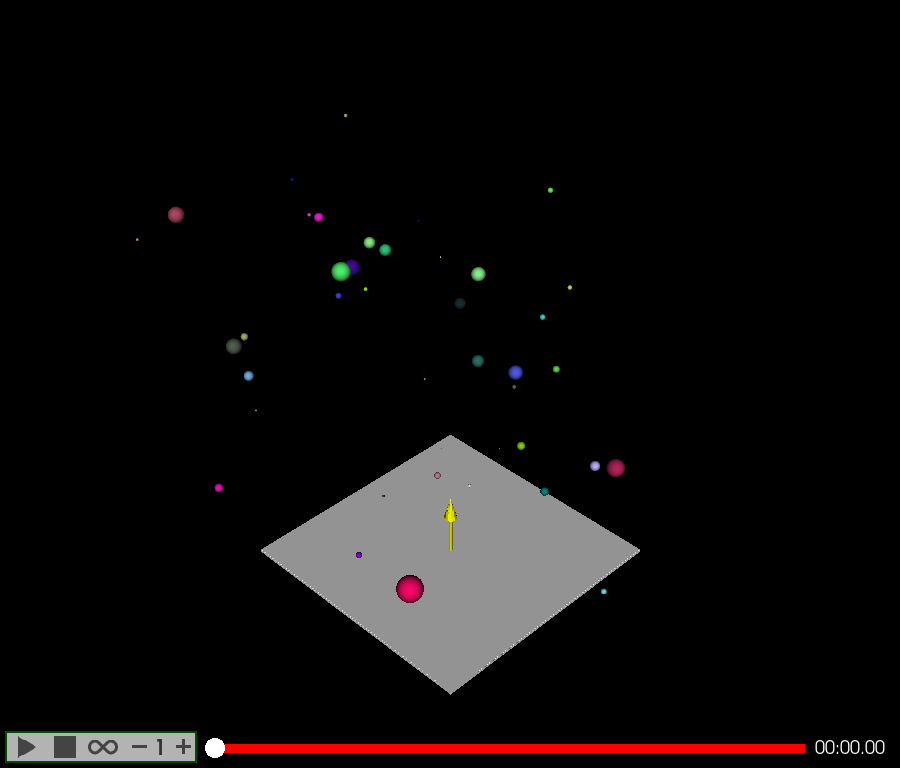Note
Go to the end to download the full example code
Keyframe animation: Camera and opacity#
Camera and opacity keyframe animation explained in this tutorial.
import fury
import numpy as np
from fury.animation import Animation, CameraAnimation, Timeline
from fury.animation.interpolator import cubic_spline_interpolator
The Plan#
The plan here is to animate (scale and translate) 50 spheres randomly, and show FURY text that appears at the end!
scene = fury.window.Scene()
showm = fury.window.ShowManager(
scene=scene, size=(900, 768), reset_camera=False, order_transparent=True
)
Creating the main Timeline and adding static actors to it#
Here we create a Timeline. so that we can use it as a controller for the
50 animations we will create.
So, Instead of updating and adding 50 Animations to the ShowManager,
we only need to update the main Timeline. Also, a playback panel can be
assigned to this main Timeline.
But, why we need 50 Animations, you may ask.
-> A single Animation can handle each property once at a time. So we need
50 Animations to translate and scale our 50 spheres.
playback_panel=True assigns a playback panel that can control the
playback of its Animations
timeline = Timeline(playback_panel=True)
Creating two actors for visualization, and to detect camera’s animations.
Creating “FURY” text#
fury_text = fury.actor.vector_text(text="FURY", pos=(-4.3, 15, 0), scale=(2, 2, 2))
Creating an Animation to animate the opacity of fury_text
text_anim = Animation(actors=fury_text, loop=False)
opacity is set to 0 at time 29 and set to one at time 35. Linear interpolator is always used by default.
text_anim.set_opacity(29, 0)
text_anim.set_opacity(35, 1)
text_anim contains the text actor is added to the Timeline.
timeline.add_animation(text_anim)
Creating and animating 50 Spheres#
for _ in range(50):
###########################################################################
# create a sphere actor that's centered at the origin and has random color
# and radius.
actors = [
fury.actor.sphere(
np.array([[0, 0, 0]]),
np.random.random([1, 3]),
radii=np.random.random([1, 3]),
)
]
###########################################################################
# create a timeline to animate this actor (single actor or list of actors)
# Actors can be added later using `Timeline.add_actor(actor)`
animation = Animation(actors=actors)
# We generate random position and scale values from time=0 to time=49 each
# two seconds.
for t in range(0, 50, 2):
#######################################################################
# Position and scale are set to a random value at the timestamps
# mentioned above.
animation.set_position(t, np.random.random(3) * 30 - np.array([15, 0, 15]))
animation.set_scale(t, np.repeat(np.random.random(1), 3))
###########################################################################
# change the position interpolator to cubic spline interpolator.
animation.set_position_interpolator(cubic_spline_interpolator)
###########################################################################
# Finally, the ``Animation`` is added to the ``Timeline``.
timeline.add_animation(animation)
Animating the camera#
Since, only one camera is needed, camera animations are preferably done using
a separate Animation.
Three properties can control the camera’s animation:
Position, focal position (referred to by focal), and up-view.
camera_anim = CameraAnimation(loop=False)
timeline.add_animation(camera_anim)
Multiple keyframes can be set at once as follows. camera focal positions
camera_positions = {
# time: camera position
0: np.array([3, 3, 3]),
4: np.array([50, 25, -40]),
7: np.array([-50, 50, -40]),
10: np.array([-25, 25, 20]),
14: np.array([0, 16, 25]),
20: np.array([0, 14.5, 20]),
}
# camera focal positions
camera_focal_positions = {
# time: focal position
15: np.array([0, 0, 0]),
20: np.array([3, 9, 5]),
23: np.array([7, 5, 3]),
25: np.array([-2, 9, -6]),
27: np.array([0, 16, 0]),
31: np.array([0, 14.5, 0]),
}
set_camera_focal can only set one keyframe, but
set_camera_focal_keyframes can set a dictionary of keyframes.
camera_anim.set_focal_keyframes(camera_focal_positions)
camera_anim.set_position_keyframes(camera_positions)
Change camera position and focal interpolators
camera_anim.set_position_interpolator(cubic_spline_interpolator)
camera_anim.set_focal_interpolator(cubic_spline_interpolator)
Adding non-animatable actors to the scene.
scene.add(arrow, plan)
Adding the timeline to the ShowManager.
showm.add_animation(timeline)
The ShowManager must go on!
interactive = False
if interactive:
showm.start()
fury.window.record(
scene=scene, out_path="viz_keyframe_animation_camera.png", size=(900, 768)
)

Total running time of the script: (0 minutes 0.387 seconds)
